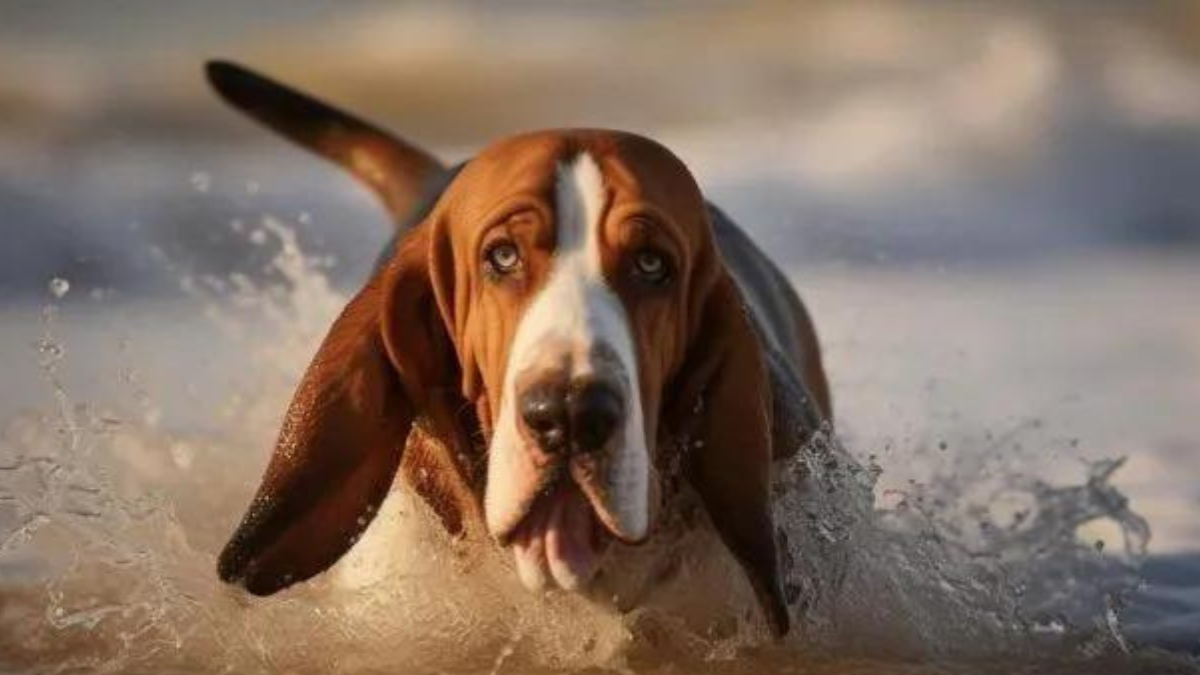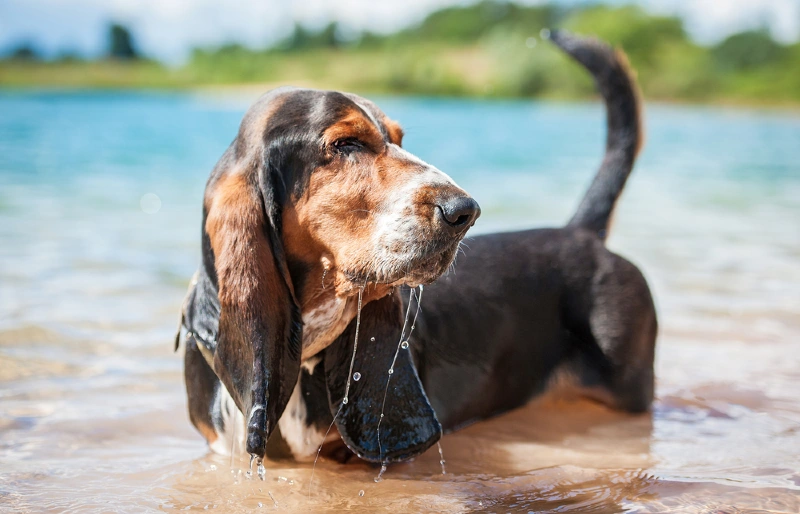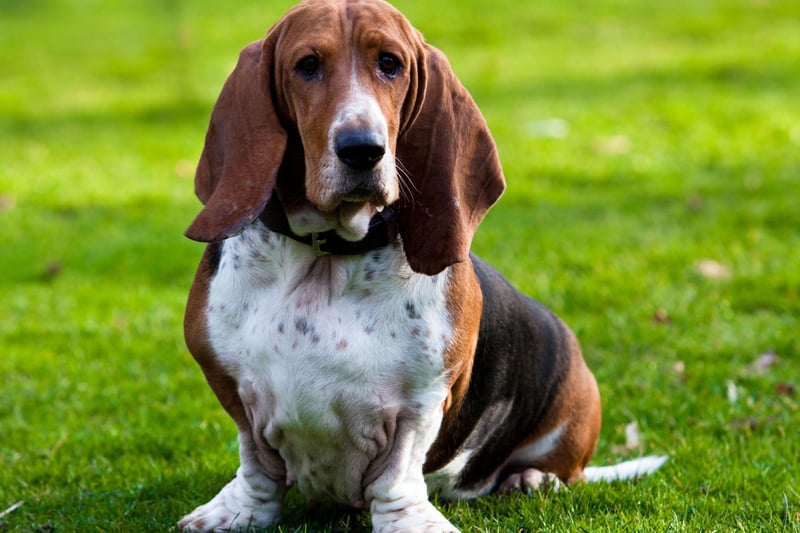Basset Hounds are renowned for their charming characteristics, from their signature floppy ears to their soulful, droopy eyes. These amiable dogs are often associated with a laid-back and lounging demeanor, but when it comes to water activities, there's some uncertainty among dog enthusiasts. The lingering question for many is, "Can Basset Hounds swim?"
The answer is yes, basset hounds can swim! While they may not be the most graceful swimmers, they are capable of staying afloat and paddling around. However, it's important to note that not all basset hounds enjoy swimming. Some may be hesitant or even fearful of the water, so it's important to introduce them to swimming slowly and patiently.
Like all dogs, basset hounds have an instinct to doggy paddle. Their long, heavy bodies may make it a bit more challenging, but with some practice and encouragement, they can become confident swimmers. It's also important to keep in mind that not all dogs are natural swimmers, so it's important to always supervise them when they're in the water.

Basset Hound Characteristics
Basset hounds are a unique breed of dog that are known for their short legs, long bodies, and floppy ears. They are medium-sized dogs that typically weigh between 40-65 pounds and stand around 12-15 inches tall at the shoulder.
Body Shape and Size
The body shape of a basset hound is long and low to the ground, with a deep chest and well-developed bone mass. This body shape is well-suited for their original purpose as hunting dogs, as it allows them to move slowly and steadily through dense underbrush. However, this body shape can also make them prone to certain health issues, such as hip dysplasia and back problems.
Leg Structure
One of the most distinctive features of basset hounds is their short, stubby legs. This leg structure is due to a genetic mutation that affects the development of the long bones in their legs. While it may seem like this would make them poor swimmers, basset hounds are quite capable in the water with proper training.
Ear Anatomy
Basset hounds are known for their long, droopy ears, which serve an important purpose in their hunting abilities. The ears help to trap scent particles and direct them towards the dog's nose, allowing them to track prey more effectively. However, this ear anatomy can also make them prone to ear infections and other ear-related health issues if not properly cared for.
Overall, basset hounds have a unique set of characteristics that make them well-suited for their original purpose as hunting dogs. While their body shape and leg structure may present certain health challenges, with proper care and training, they can lead happy and healthy lives as beloved family pets.

Understanding Basset Hounds and Water
Basset Hounds are known for their love of water, but can they swim? In this section, we will explore their natural affinity for water and their historical background.
Natural Affinity for Water
Basset Hounds have a natural affinity for water. They are descendants of the Bloodhound, which was bred for hunting in France. Bloodhounds are known for their ability to track scents over long distances, and they were often used for hunting in wetlands and marshes.
Basset Hounds inherited this love for water from their ancestors. They have webbed paws that help them swim and navigate through water. They also have a thick, water-resistant coat that keeps them warm and dry.
However, it is important to note that not all Basset Hounds enjoy swimming. Some may be hesitant or afraid of the water, while others may love it. It is important to introduce them to water gradually and ensure their safety at all times.
Historical Background
Basset Hounds were originally bred in France in the 16th century for hunting small game, such as rabbits and hares. They were used in packs and worked closely with their handlers to track and flush out prey.
Their short legs and long ears were specifically bred for hunting in dense vegetation, and their love for water made them ideal for hunting in wetlands and marshes.
Today, Basset Hounds are popular pets and companions. While they may not be used for hunting as much as they were in the past, their natural affinity for water still makes them great swimmers and water enthusiasts.
In conclusion, Basset Hounds have a natural affinity for water and can be great swimmers. However, it is important to introduce them to water gradually and ensure their safety at all times. Their love for water can be traced back to their hunting ancestry in France, where they were used for hunting in wetlands and marshes.

Safety Measures for Swimming
Swimming can be a fun activity for your Basset Hound, but it's important to ensure their safety while they're in the water. Here are some safety measures that you can take to ensure that your Basset Hound stays safe while swimming.
Life Jackets and Vests
A life jacket or vest is an essential safety measure for your Basset Hound while swimming. It can help keep them afloat and prevent them from drowning. When selecting a life jacket or vest, make sure that it fits your Basset Hound properly and is designed for their size and weight.
Supervised Swimming
It's important to supervise your Basset Hound while they're swimming. Never leave them unattended, even if they're wearing a life jacket or vest. Keep a close eye on them and be ready to help them if they start to struggle in the water.
Securing the Swimming Area
Make sure that the swimming area is secure and safe for your Basset Hound. If you have a pool, make sure that it's fenced off and that your Basset Hound can't accidentally fall in. Keep the area around the pool free of hazards, such as sharp objects or slippery surfaces.
By following these safety measures, you can ensure that your Basset Hound stays safe while swimming. Remember to always prioritize their safety and enjoyment while in the water.

Swimming Training and Techniques
Introducing Basset Hounds to Water
Basset Hounds are not natural swimmers and may require some training to feel comfortable in the water. The first step is to introduce them to shallow water, such as a kiddie pool or a shallow lake. It is important to be patient and never force them into the water. Instead, use treats to encourage them to approach the water and reward them for their bravery.
Building Confidence in Water
Once your Basset Hound is comfortable in shallow water, you can gradually move to deeper water. Start by standing in the water with your dog, holding them close and offering reassurance. Gradually move further away from them and encourage them to swim towards you. Always stay close by and never leave your dog unattended in the water.
Advanced Swimming Lessons
If your Basset Hound has mastered the basics of swimming, you can move on to more advanced techniques. This may include retrieving objects from the water or teaching them to swim longer distances. It is important to always monitor your dog's mood and never push them beyond their limits.
Overall, with patience and consistent training, Basset Hounds can learn to swim and enjoy the water. Remember to always provide positive reinforcement and never force your dog into the water.
Health Considerations
When it comes to the health of Basset Hounds, there are a few important considerations to keep in mind, especially when it comes to their ability to swim.
Ear Care and Infections
Basset Hounds are known for their long, floppy ears, which can make them more prone to ear infections. It is important to keep their ears clean and dry to prevent infections, especially after swimming. Using a drying solution recommended by a veterinarian can help prevent moisture from getting trapped in the ear canal and leading to infection.
Physical Strain and Stamina
While Basset Hounds may enjoy the water, they are not the best swimmers due to their body structure. Their short legs and long bodies make it difficult for them to swim for extended periods, and they can easily become fatigued. Owners should monitor their Basset Hound's stamina and never leave them unattended in water.
Basset Hounds also require regular exercise to maintain their physical health. Swimming can be a great way to provide low-impact exercise, but it is important to start slow and gradually increase the intensity and duration of swimming sessions.
Overall, Basset Hounds can enjoy swimming with proper precautions and care. Owners should be aware of their unique body structure and potential health concerns, such as ear infections, to ensure their Basset Hound stays healthy and happy.

Recreational Swimming for Basset Hounds
Basset Hounds are not known for their swimming abilities, but they can enjoy recreational swimming if done in the right environment. Here are some tips for ensuring your Basset Hound has a fun and safe time in the water.
Choosing the Right Environment
When it comes to swimming with Basset Hounds, it's important to choose the right environment. A kiddie pool or a backyard pool can be a great option for those who want to introduce their dog to water. These options allow for a controlled environment where you can monitor your dog's behavior.
If you're planning to take your Basset Hound to a lake or beach, it's important to ensure that the area is safe for swimming. Check for any potential hazards such as strong waves, currents, or sharp rocks. Always keep your dog on a leash and supervise them closely.
Fun Water Activities
Once you've chosen the right environment, it's time to have some fun! Basset Hounds may not be the most athletic swimmers, but they can enjoy water activities such as retrieving their favorite toy.
Playing fetch in the water can be a great way to exercise your Basset Hound while keeping them cool. Just make sure to choose a toy that floats and is easy for your dog to retrieve.
If your Basset Hound is comfortable with waves, taking them to the beach can be a fun experience. Just be sure to supervise them closely and keep them on a leash.
In conclusion, while Basset Hounds may not be natural swimmers, they can still enjoy recreational swimming in the right environment. By following these tips, you can ensure that your Basset Hound has a safe and enjoyable time in the water.
Caring for Your Basset Hound Post-Swim
After a fun swim in the pool or at the beach, it is important to take proper care of your basset hound to ensure their health and safety. This section will cover some important tips on how to care for your basset hound after a swim.
Cleaning and Grooming
Basset hounds have floppy ears which can trap water and moisture, leading to the growth of bacteria and yeast. Therefore, it is important to dry their ears thoroughly after a swim. Use a soft towel to gently wipe the inside of their ears to prevent any infections.
In addition, basset hounds have a thick coat that can also trap water and sand. It is recommended to give them a bath after a swim to remove any chlorine or salt water from their coat. Use a gentle shampoo and conditioner to avoid irritating their skin. It is also important to brush their coat to remove any tangles or mats.
Monitoring for Health Issues
While swimming can be a fun activity for basset hounds, it is important to supervise them at all times to ensure their safety. They may not be strong swimmers and can easily tire out, leading to drowning. It is also important to keep them away from strong currents or waves.
Chlorine in pool water can also be harmful to basset hounds. It can cause skin irritation and gastrointestinal issues if they ingest too much water. Therefore, it is important to rinse them off with fresh water after a swim to remove any chlorine residue from their coat.
If your basset hound shows any signs of illness after a swim, such as vomiting or diarrhea, it is important to contact your veterinarian. They may have ingested too much water or may have an infection from bacteria in the water.
Overall, with proper care and supervision, basset hounds can enjoy a fun swim without any health issues.
Basset Hound Swimming Stories
Basset Hounds are known for their short legs and long bodies, which often leads people to wonder if they can swim. While not all Basset Hounds are natural swimmers, many have proven to be quite adept in the water. Here are some inspiring Basset Hound swimming stories:
Inspirational Swimming Tales
Jack was a Basset Hound who loved to swim. His owner, Sarah, would take him to the lake every summer, where he would happily paddle around for hours. One day, Jack spotted a small child who had fallen into the water and was struggling to stay afloat. Without hesitation, Jack swam over to the child and helped keep him above water until help arrived. Thanks to Jack's quick thinking and swimming skills, the child was safely rescued.
Hank was a rescue Basset Hound who had never been in the water before. His new owners, John and Mary, were unsure if he would take to it but decided to give it a try. They slowly introduced him to the water, and to their surprise, Hank began to swim on his own. Over time, he became more confident and would eagerly jump into the pool whenever he had the chance.

Swimming Basset Hounds in Pop Culture
Bella, the Basset Hound from the popular children's book "A Very Brave Witch", was known for her love of swimming. In the book, Bella helps the witch save a group of animals from a flood by swimming them to safety.
Beau was a Basset Hound who starred in the movie "The Ugly Dachshund". In the movie, Beau's owners try to pass him off as a Dachshund in a dog show. In one scene, Beau impresses the judges by swimming across a pool to retrieve a toy.
George was a Basset Hound who became famous for his swimming skills on social media. His owner, Tom, would post videos of George swimming in their backyard pool, and they quickly went viral. George became known as the "swimming Basset Hound", and even appeared on several TV shows.
Toby was a Basset Hound who made headlines when he swam across a lake to reunite with his owner, who had been fishing on the other side. Toby's owner was amazed that he was able to swim such a distance, and many people were inspired by Toby's determination and loyalty.
In conclusion, while not all Basset Hounds are natural swimmers, many have proven to be quite skilled in the water. These inspiring stories show that with patience and training, Basset Hounds can become confident swimmers.
Conclusion
In conclusion, answering the lingering question, "Can Basset Hounds swim?" reveals that while their iconic features like short legs and a heavy build may present challenges, many Basset Hounds can become adept swimmers with patient guidance. Their comfort levels vary, emphasizing the importance of introducing them to water gradually. Some may embrace aquatic activities with enthusiasm, while others may require a more cautious approach.
Owners play a crucial role in fostering a positive relationship between Basset Hounds and swimming by offering support, using floatation devices when needed, and respecting each dog's unique preferences. So, while not natural water dogs, Basset Hounds can certainly enjoy the occasional dip, turning a potential challenge into a delightful experience with the right approach.
Frequently Asked Questions
- Are Basset Hounds naturally good swimmers?
- Basset Hounds are not known for being natural swimmers. Due to their short legs and heavy body structure, they may struggle in the water. However, some Basset Hounds may enjoy swimming and be comfortable in the water with proper training and supervision.
- What should I consider when introducing my Basset Hound to water?
- When introducing your Basset Hound to water, it is important to start slowly and in a shallow area. Use positive reinforcement and treats to encourage them to approach the water. Make sure to supervise them at all times and use a life jacket for added safety.
- Can Basset Hound puppies learn to swim safely?
- Yes, Basset Hound puppies can learn to swim safely with proper training and supervision. It is important to start with short sessions in shallow water and gradually increase the depth and duration of the swim.
- What safety measures should I take when my Basset Hound is swimming?
- When your Basset Hound is swimming, it is important to always supervise them and keep them within reach. Use a life jacket for added safety and make sure they have an easy exit from the water. Avoid swimming in strong currents or deep water.
- How does the Basset Hound's body structure affect its swimming ability?
- The Basset Hound's heavy body structure and short legs can make it difficult for them to swim. They may tire easily and struggle to keep their head above water. However, with proper training and supervision, some Basset Hounds can become comfortable and confident swimmers.
- Do Basset Hounds enjoy water activities or should they be kept away from water?
- Some Basset Hounds may enjoy water activities, while others may not. It is important to introduce your Basset Hound to water gradually and observe their behavior. Always supervise them when they are near water and use a life jacket for added safety.




